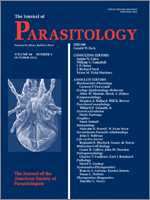Riouxgolvania kapapkamui sp. n. (Nematoda: Muspiceoidea: Muspiceidae), a peculiar intradermal parasite, is described based on gravid adults, eggs, and first-, second-, and third-stage larvae collected from dermal nodules formed in Myotis macrodactylus and Myotis ikonnikovi bats from Hokkaido, Japan. The nematode is readily distinguished from 3 previously described congeners in having a globular body with brown, transverse striae in the anterior region of fully grown females. The third-stage larva is also distinguished from other congeners by having a round tail end. Nucleotide sequences of the analyzed partial SSU rDNA-ITS1 region and partial cytochrome c oxidase subunit 1 of mtDNA showed greater similarity to chromadoreans rather than to enopleans. This is the first report of muspiceoid nematodes from Asia.
How to translate text using browser tools
1 October 2012
Description of Riouxgolvania kapapkamui Sp. N. (Nematoda: Muspiceoidea: Muspiceidae), A Peculiar Intradermal Parasite of Bats in Hokkaido, Japan
Hideo Hasegawa,
Masahiko Satô,
Kishio Maeda,
Yoshiko Murayama
ACCESS THE FULL ARTICLE

Journal of Parasitology
Vol. 98 • No. 5
October 2012
Vol. 98 • No. 5
October 2012




